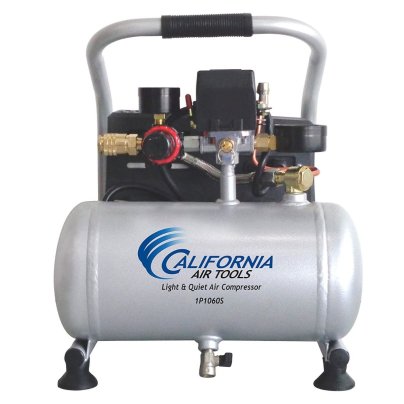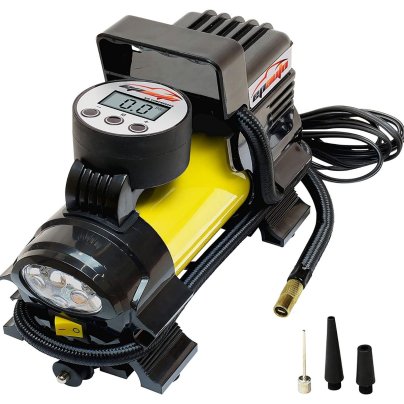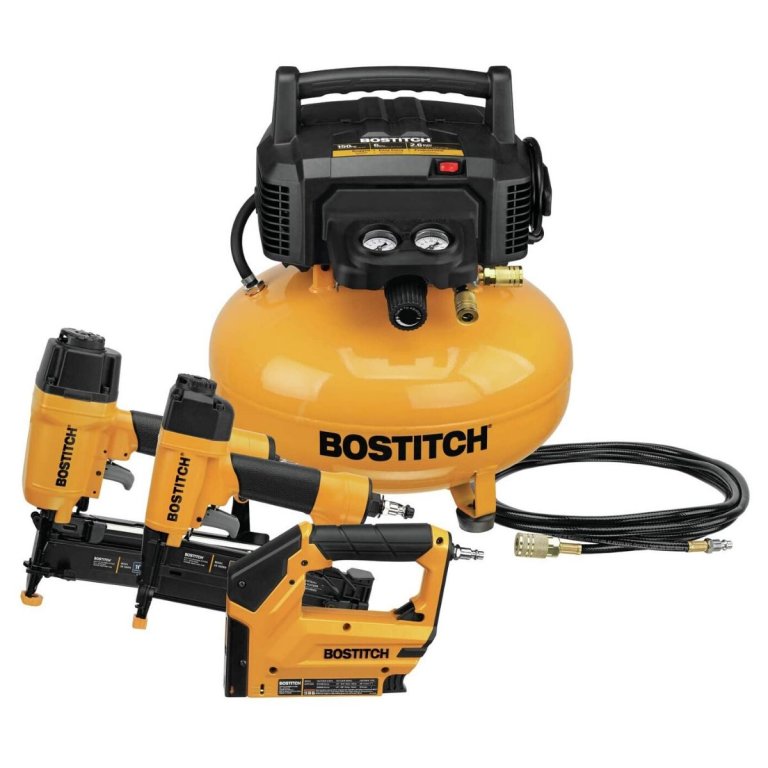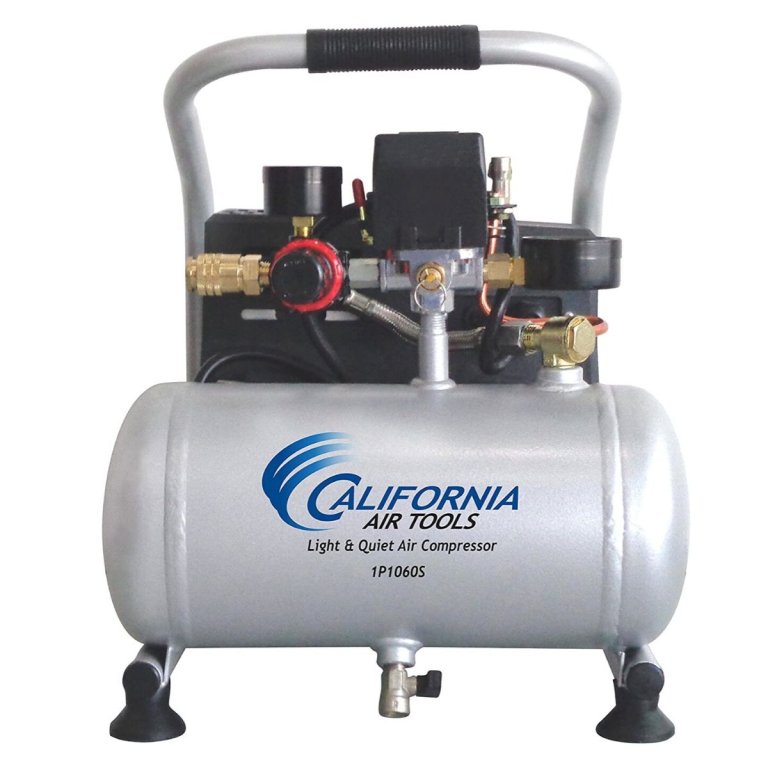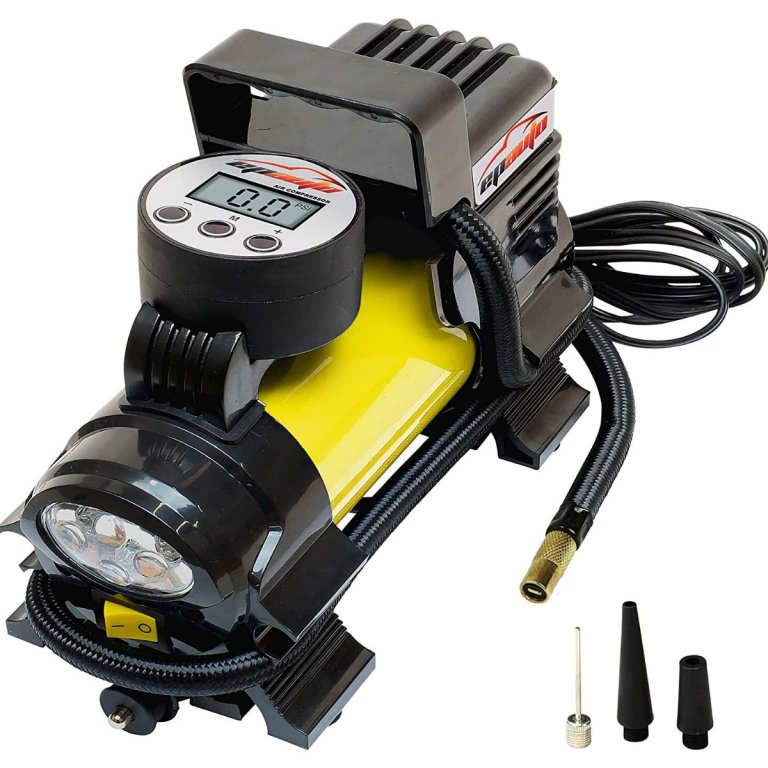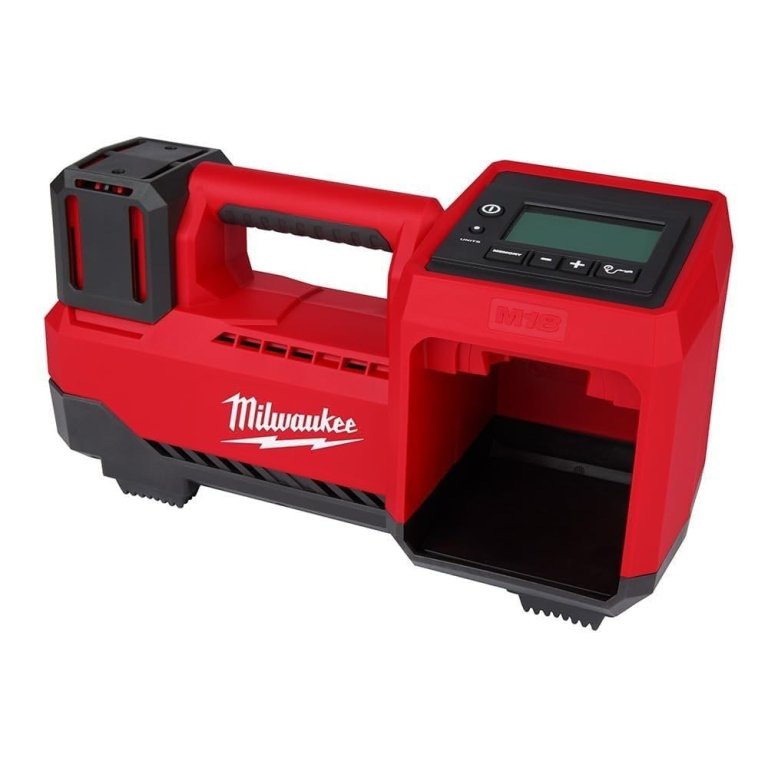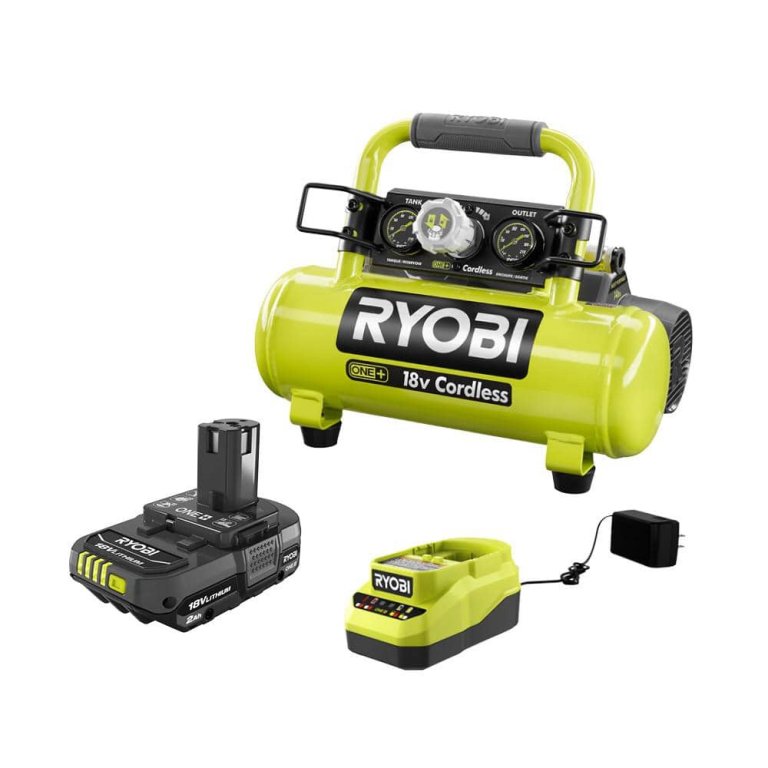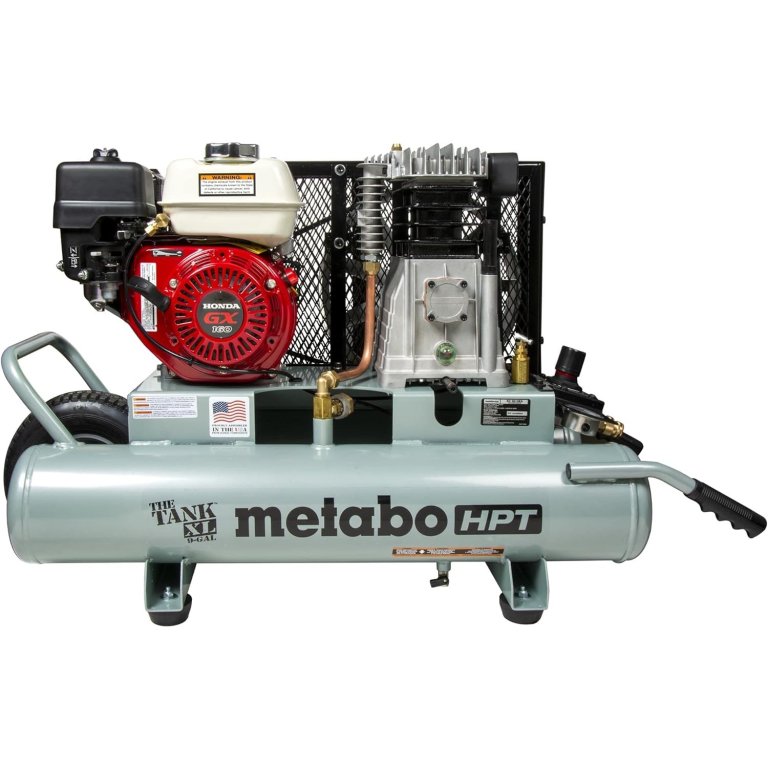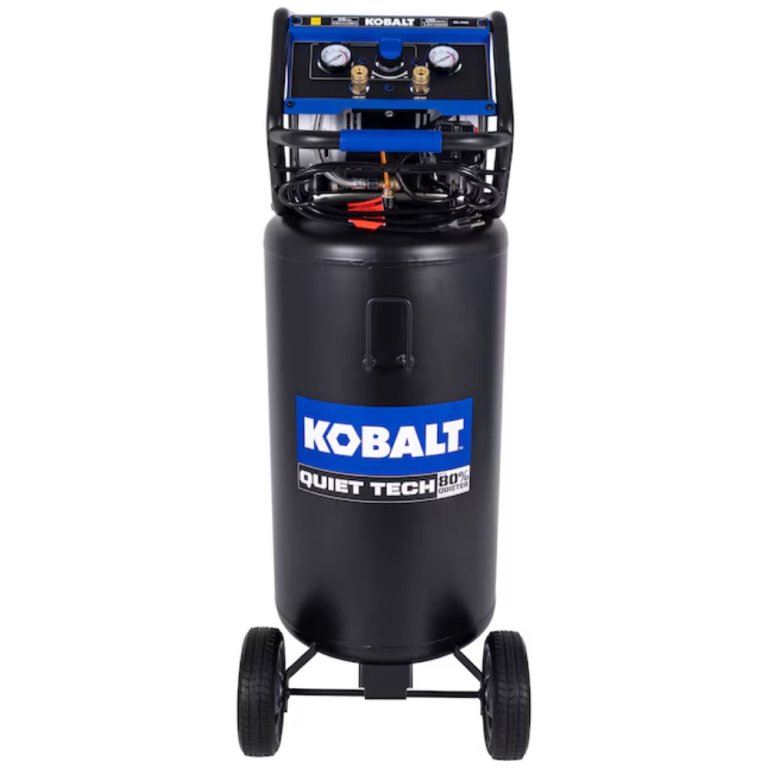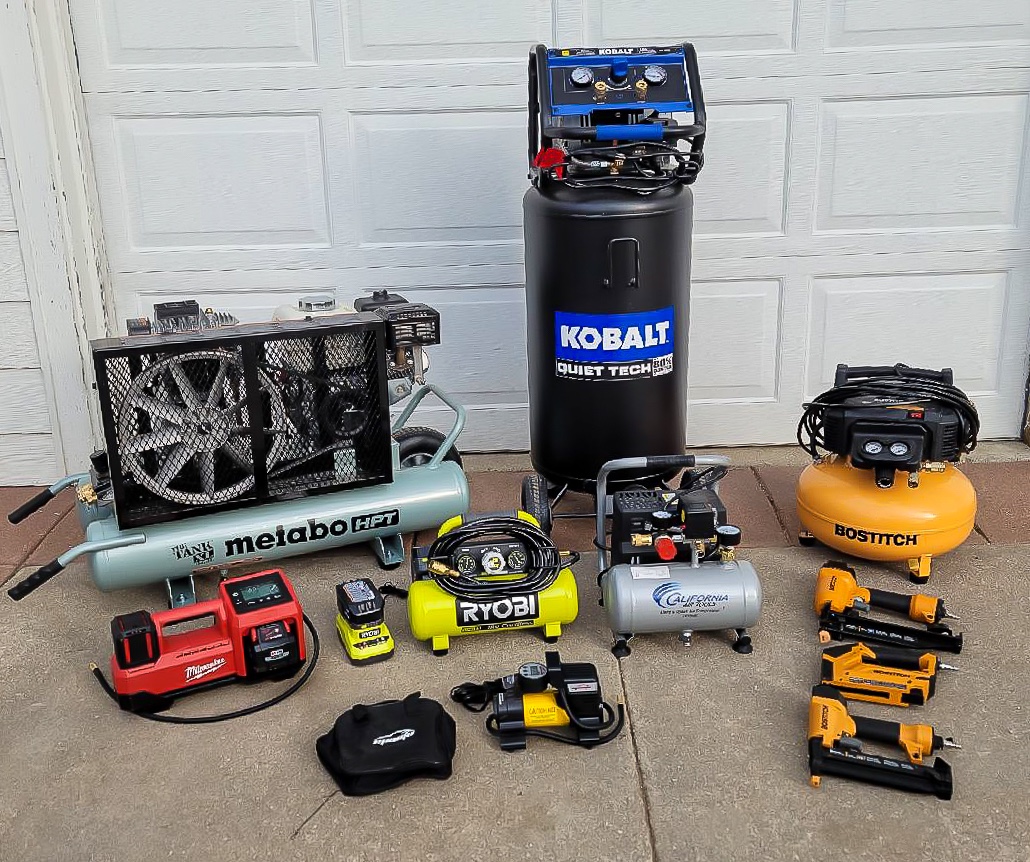
We may earn revenue from the products available on this page and participate in affiliate programs. Learn More ›
Lightweight and versatile, pneumatic tools are high performers for many household tasks, ranging from inflating car tires to driving nails remotely to building a fence on the back forty. But to use a pneumatic tool, you’ll want to partner it with an air compressor that can deliver the air to power it. While compressors vary widely in weight, volume, and portability, the best ones offer more than enough air pressure for the desired task at hand.
We tested today’s most popular home air compressors in our own driveways, garages, and outbuildings to see how well they fared in real-world settings. Some of today’s new models really surprised us with their impressive performances.
Read on to find out how the following models earned a spot in this tested lineup of today’s best home air compressors.
- BEST OVERALL: Bostitch 3-Tool Air Compressor Combo Kit
- BEST BANG FOR THE BUCK: California Air Tools 1P1060S Portable Air Compressor
- BEST FOR CAR TIRES: EPAuto 12V DC Portable Air Compressor Pump
- BEST FOR TRUCK TIRES: Milwaukee M18 18V Cordless Tire Inflator
- BEST FOR SMALL PROJECTS: Ryobi One+ 18V Cordless 1-Gal. Air Compressor Kit
- BEST GAS-POWERED: Metabo HPT The Tank XL 9-Gal. Wheelbarrow Compressor
- BEST HOME SHOP: Kobalt Quiet Tech 150 PSI 26-Gal. Air Compressor
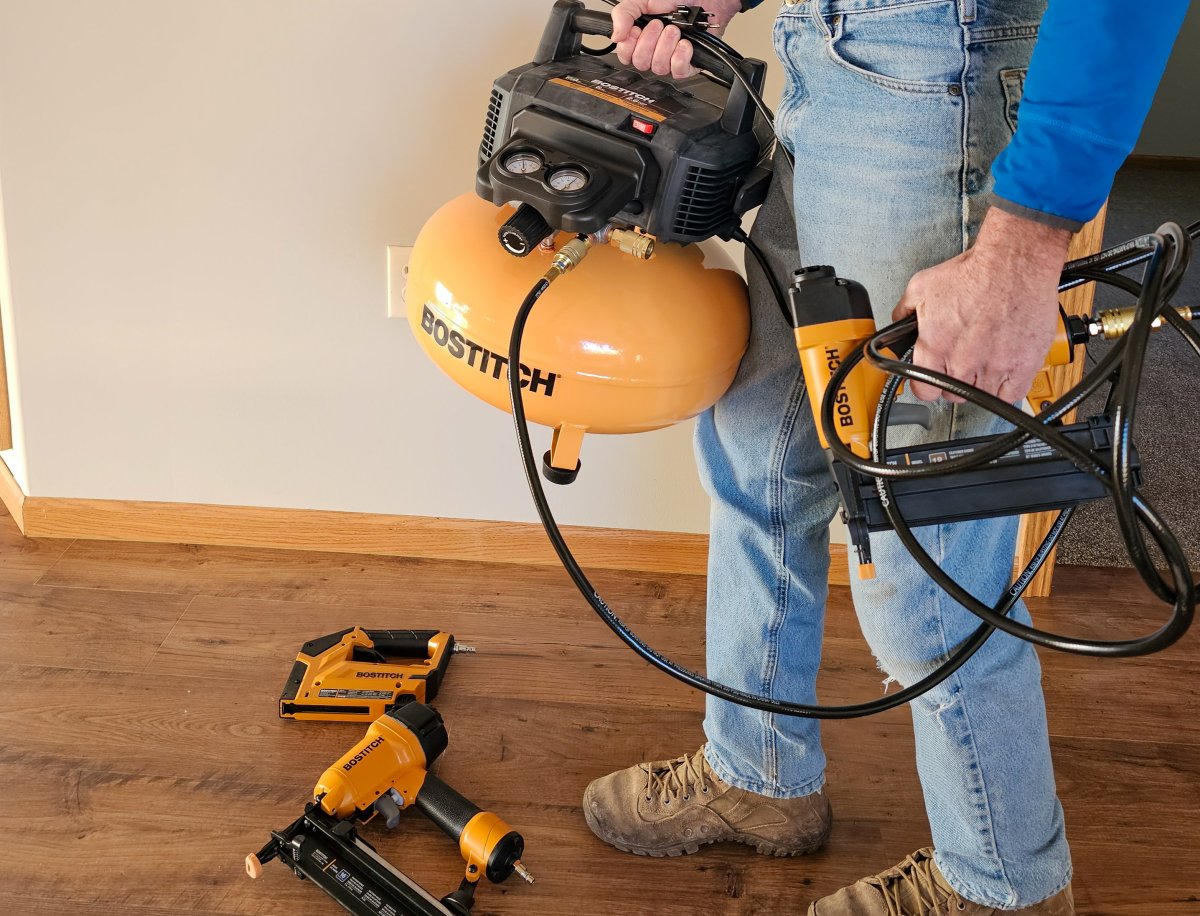
How We Tested the Best Home Air Compressors
We started by researching more than 35 highly rated air compressors, looking for top models in several home use categories. To narrow down the number for testing, we first considered the brand. Manufacturers such as California Air Tools and Bostitch are well respected in the air compressor industry. We also looked closely at flagship home improvement brands, such as Ryobi from The Home Depot and Kobalt from Lowe’s. For the final cut in our quest to find the best air compressor, we selected only top-rated models with high consumer confidence.
When the air compressors arrived, we assembled them, adding oil to crankcases when necessary and attaching wheels and handles. We then tested each air compressor with pneumatic tools designed for the pressure supplied by the compressor. We noted cycle run/recovery times, pressure consistency, and ease of use. We also paid attention to noise levels and portability. We awarded points based on a rubric: The better an air compressor performed on a test, the more points it earned. After testing, we averaged the points to determine our top picks and decide the best use case for each model.
Testing Stats
- Products tested: 8
- Hours spent testing: 20+
- Tests performed: 4
- Price range: $30 to $1,300
Our Top Picks
The following list is a roundup of the best-performing home air compressors from our tests. You’ll find various intended uses and power capabilities, but each one stood out in our hands-on testing and earned its place in this lineup. One of these models will surely be a good fit for your home air power needs.
Best Overall
Bostitch 3-Tool Air Compressor Combo Kit
Pros
- Pancake-style compressor weighs 45 pounds and comes with a large carry handle
- Kit includes 3 pneumatic tools plus an air hose and sample fasteners
- Oil-free operation results in less maintenance and virtually no toxic fumes
Cons
- Produces 80 decibels (dB) of noise, making it potentially unsuitable for indoor use
- May not be sufficient for powering heavy-duty air tools or for continuous use
Product Specs
- Type: Electric
- Max pounds per square inch (PSI): 150
- Cubic feet per minute (CFM) at 90 PSI: 2.6
Our Ratings: Ease of Use 5/5; Power 4.5/5; Noise 4/5; Portability 5/5; Value 5/5
Bostitch’s 6-gallon pancake compressor produces up to 150 PSI of pressure and offers two connection ports so that users can power two air tools simultaneously. This air compressor comes with three Bostitch-branded tools: an 18-gauge brad nailer, a 16-gauge finish nailer, and a 0.375-inch crown stapler, plus sample fasteners for each.
We tested all three of the tools, and the pancake compressor easily supplied enough air power to run each of them. We also tested the compressor in a real-job situation—powering a roofing nailer and installing shingles—and it supplied all the pressure we needed. On a whim, we connected an impact wrench and used it to remove the lugs from a car tire. The Bostitch was successful there, too, although it cycled more frequently.
It wasn’t the quietest air compressor in our tests, but it wasn’t the loudest either. The Bostitch produces about 80 dB of noise during its recovery, which is comparable to lively conversation or an alarm clock. It may be a little too loud for indoor use where noise levels must be limited, but it’s a good pick for outdoor projects.
If you’re looking for a pancake-style compressor that’s powerful enough to power standard DIY air tools and comes with three quality tools, check out this Bostitch compressor kit.
Read our full review: Bostitch 3-Tool Air Compressor Combo Kit
Get the Bostitch home air compressor at Amazon, Lowe’s, or Walmart.
Best Bang for the Buck
California Air Tools 1P1060S Portable Air Compressor
Pros
- Quiet to run—generates just 56 dB, making it great for indoor projects
- The compressor is lightweight enough to carry where needed easily
- Despite being small, the air compressor can power brad nailers and construction staplers
- Recovers quickly (12 to 13 seconds in our tests), so there’s little to no downtime
Cons
- Not powerful enough for tools that require high levels of continuous airflow
Product Specs
- Type: Electric
- Max PSI: 120
- CFM at 90 PSI: 1.2
Our Ratings: Ease of Use 5/5; Power 4.5/5; Noise 5/5; Portability 4/5; Value 5/5
Looking for a versatile home compressor that doesn’t cost a lot? Check out the California Air Tools 1P1060S. This affordable compressor weighs just 29 pounds and features a 1-gallon steel air tank. When it cycles on, it generates just 56 dB of noise—comparable to casual conversation. In our tests, it was simple to use and easy to carry.
Initially, we wondered whether a compressor this compact and quiet would stand up to anything more than airbrushing, but we were pleasantly surprised. Although the 1P1060S did a great job with our airbrush, it also powered a brad nailer and a construction stapler and inflated the oversize tires on our truck.
This compressor delivers 1.2 CFM at 90 PSI, and we were impressed at how quickly it recovered when we had used enough pressure to trigger the recovery cycle. It took just 12 to 13 seconds for it to power back up to its maximum at 120 PSI.
While it isn’t designed to power high-capacity pneumatic tools, such as impact wrenches or commercial spray guns, it delivers reliable power for smaller air tools. Best of all, it’s super quiet, so it works well as a light-duty home compressor and for indoor use.
Get the California Air Tools home air compressor at Amazon, Lowe’s, or The Home Depot.
Best for Car Tires
EPAuto 12V DC Portable Air Compressor Pump
Pros
- Lightweight, compact, and highly portable; suitable for stowing in the trunk of a car
- Having an inflator-type air compressor in the car ensures you can fill up tires anywhere
- Plugs into a car’s 12-volt port (cigarette lighter) for power anywhere
- Can be used to fill up bicycle tires as well as car tires
Cons
- Not powerful enough to inflate heavy-duty truck tires, but still a good car air compressor
Product Specs
- Type: Electric
- Max PSI: 70
- CFM at 90 PSI: N/A
Our Ratings: Ease of Use 4/5; Power 4/5; Noise 5/5; Portability 5/5; Value 4.5/5
EPAuto’s portable air compressor pump can’t power nail guns, staplers, sprayers, or other pneumatic tools, but it can serve as a great companion in a roadside emergency. This handy little compressor can deliver up to 70 PSI, providing enough air power to inflate vehicle tires and other inflatables such as balls and bike tires. (Do note that it doesn’t have the oomph for large truck tires.)
As soon as we plugged the compressor in and flipped it on, it started cycling. It has a digital gauge, and we toggled through several metric measurements before locating the PSI setting. The compressor has a valve for filling vehicle and bicycle tires, and we filled up both.
We purposely released the air from some of our car tires and then used the EPAuto compressor to fill them back up to the recommended pressure. It performed admirably. The compressor shut off automatically once the tire reached the preset pressure.
We really liked the thoughtful built-in flashlight, which would be very useful when inflating a tire at night. This portable air compressor plugs into a vehicle’s 12-volt socket (cigarette lighter) and inflates the tire to running pressure to help get you back on the road. When stowed in the trunk, this little air compressor offers peace of mind and a quick fix for tires with slow leaks.
Get the EPAuto home air compressor at Amazon or Walmart.
Best for Truck Tires
Milwaukee M18 18V Cordless Tire Inflator
Pros
- Powerful enough to inflate pickup truck tires as well as car tires, bike tires, and more
- Compatible with all Milwaukee M18 rechargeable batteries (not included)
- Common pressure settings can be stored in memory for quick use
- Pump shuts off automatically when the desired tire pressure level is reached
Cons
- This is a tool-only inflator; battery and charger are not included
Product Specs
- Type: Rechargeable battery
- Max PSI: 150
- CFM at 90 PSI: Not rated at 90 PSI; 1.10 standard cubic feet per minute (SCFM) at 35 PSI
Our Ratings: Ease of Use 4.5/5; Power 5/5; Noise 5/5; Portability 5/5; Value 4.5/5
Car tire inflators will inflate basketballs, bike tires, and most passenger car tires, but they typically aren’t powerful enough to fill the larger tires on pickup trucks. With the Milwaukee inflator, truck tires are no problem.
Unlike standard air compressors, this inflator doesn’t have a pressurized air tank; instead, it features a robust pump that forces compressed air through the air compressor hose and into the tire. The inflator draws its power from a Milwaukee M18 rechargeable battery (battery and charger sold separately). If you own other cordless M18 Milwaukee power tools, their batteries will interchange with this inflator. Runtime will depend on the capacity of the battery you use.
We really liked the option to inflate tires to a preset pressure. The Milwaukee inflator features a digital screen and scroll buttons that allowed us to select the desired pressure. We selected 80 PSI on the screen and connected the valve to our pickup’s 10-ply tires. Watching the screen, we could see the tire pressure increase as the Milwaukee inflator went to work airing it up. As soon as the pressure reached 80 PSI, the inflator shut off.
Like all Milwaukee tools, this inflator is well built—it’s made from impact-resistant materials, and an accidental fall from our truck bed didn’t harm it. Don’t miss this one if you’re looking for an on-the-go inflator that can inflate pickup tires.
Get the Milwaukee home air compressor at Amazon or The Home Depot.
Best For Small Projects
Ryobi One+ 18V Cordless 1-Gal. Air Compressor Kit
Pros
- Lightweight and highly portable air compressor thanks to its battery power
- Small, but has a maximum 120 PSI, making it versatile enough for various tasks
- Can be used in remote locations where electricity is not available
Cons
- Limited battery life (about 1 hour if used consistently), which may be too little to complete some tasks
Product Specs
- Type: Battery operated
- Max PSI: 120
- CFM at 90 PSI: 0.5
Our Ratings: Ease of Use 5/5; Power 4.5/5; Noise 4/5; Portability 5/5; Value 4.5/5
If you’re looking for a small air compressor to power light-duty tools and you want it to be battery operated, look no further than the Ryobi One+ 18V air compressor. It has a 1-gallon tank, 120 PSI max pressure, and a CFM of 0.5 at 90 PSI.
It comes completely assembled, but we did have to charge the 2 amp-hour battery, which took about 2 hours to complete. Then, we started testing. We attached a brad nailer and fired dozens of brads into hardwood trim at the rate of about one every 5 to 10 seconds, which is comparable to how often we’d shoot a brad when installing trim. The Ryobi compressor performed excellently—we were able to continue shooting brads throughout its recovery cycle. We also used it to inflate car tires and to power our airbrush. It did both very well, and our tools never ran out of air pressure.
This little air compressor weighs just 14 pounds and comes with a padded nonslip handle for carrying. Both the battery and charger are included. In our testing, the battery ran for about 1 hour with constant use. You could expect to get more time out of it if you use it on a less constant basis, such as nailing brads for a few minutes and then measuring and cutting additional trim, which is more realistic. You can also buy a higher-capacity Ryobi 18-volt battery to increase the compressor’s runtime.
If you store this little air compressor in a closet, utility room, basement, or garage and charge the battery before storing it, you’ll have reliable air power for small tasks whenever you need it.
Get the Ryobi home air compressor at The Home Depot.
Best Gas-Powered
Metabo HPT The Tank XL 9-Gal. Wheelbarrow Compressor
Pros
- Extremely powerful; capable of powering many pneumatic tools
- Gas-powered engine makes it possible to use the compressor without access to an electrical outlet
- Recoil start worked well in testing, even in freezing temperatures
- Wheelbarrow handles and large front wheel provide convenient portability
Cons
- Weighs 159 pounds, which might make it challenging to move for some users
- Louder than most; registered 87 dB in testing
Product Specs
- Type: Gas-powered
- Max PSI: 145
- CFM at 90 PSI: 9.5
Our Ratings: Ease of Use 4.3/5; Power 5/5; Noise 3/5; Portability 4/5; Value 4/5
If you need mobile air power to build a fence or shingle the roof on an off-grid cabin, a fuel-powered air compressor is just the ticket. We tested the Metabo HTP gasoline-powered air compressor, aptly named “The Tank XL.” This type of compressor is designed to provide a high level of air power when you don’t have access to an electrical outlet.
We used The Tank for powering a roofing nailer while shingling a remote storage shed, and we also tested it with a framing nailer, a high-capacity paint sprayer, a blower, a finish nailer, and a tire inflator. It supplied more than enough air power for every test. It produces a max PSI of 145 and an impressive airflow of 9.5 CFM at 90 PSI. It comes with a dependable Honda GX gas engine, and we had no problems starting it with the recoil cord—even in below-freezing temps.
This wheelbarrow-type air compressor is semiportable, with a large front wheel and barrow-type handles. But it’s not lightweight—The Tank weighs a beefy 159 pounds, and even with the handles and wheel, it took some effort to roll it around. This type of compressor is well suited to carrying or mounting on a truck or trailer bed, where it’s ready to run pneumatic tools wherever you need the power.
Because it’s fuel-powered, it can’t be used indoors, and it is loud. The manufacturer doesn’t list the decibels, but our decibel tester registered 87 dB from about 6 feet away.
Get Metabo HPT home air compressor at Amazon, Lowe’s, or White Cap.
Best Home Shop
Kobalt Quiet Tech 150 PSI 26-Gal. Air Compressor
Pros
- Capable of powering most pneumatic tools, including nail guns, impact wrenches, and paint spray guns
- High airflow of 4.5 CFM at 90 PSI offers consistent power for standard air tools
- Large 26-gallon tank supplies ample air, which reduces the need for frequent cycling
- Produces just 70 dB, making it a good pick for shops where noise is a concern
Cons
- Weights nearly 126 pounds; users might find it challenging to lift and load the compressor
Product Specs
- Type: Corded electric
- Max PSI: 150
- CFM at 90 PSI: 4.5
Our Ratings: Ease of Use 4.7/5; Power 5/5; Noise 5/5; Portability 4/5; Value 5/5
If you’re in the market for an air compressor that will power nail guns, blowers and even paint sprayers, look no further than the 26-gallon Kobalt air compressor from Lowe’s. This top-notch shop compressor weighs 125.66 pounds, so loading it on a truck bed might be challenging, but thanks to oversize tires and a handle, we had no problem pulling it around the floor in our shop.
Despite its power, this compressor produces just 70 dB during its recovery cycle, which was an unexpected treat during our testing. With its sizable 26-gallon tank, 4.5 CFM at 90 PSI, and a maximum PSI of 150, this upright Kobalt compressor is a powerhouse that can tackle many workshop projects.
We tested its performance using a framing nailer, an impact wrench, a belt sander, and a high-capacity paint spray gun, and it powered all of them without running out of steam. We still had ample airflow even during its recovery cycle.
In short, the Kobalt maintains consistent airflow without producing earsplitting noise, making it an excellent option for a home workshop or even DIY auto-mechanic use.
Get the Kobalt home air compressor at Lowe’s.
Jump to Our Top Picks

How to Choose an Air Compressor
Before you buy a new air compressor, take a few minutes to learn about the essential features to consider and how project type and intended use determine the type of air compressor that might best fit the job.
Pounds per Square Inch and Cubic Feet per Minute
PSI is a measurement of pressure that conveys how much force an air compressor can deliver. For most DIY projects, PSI is not typically a concern, as these projects usually demand less pressure than what even a low-end air compressor can supply.
However, PSI offers an excellent indication of the air compressor’s output capacity. For example, a 2-gallon air compressor tank rated at 150 PSI can hold more than a 2-gallon tank rated at 100 PSI. That’s because the air inside the first tank is more highly pressurized, which reduces the volume that the air particles occupy, allowing more air to fit inside a tank of the same size.
The maximum PSI of air compressors typically available for DIY projects ranges from 90 to 150 PSI. You’d only need higher than 150 PSI for jobs such as automotive repairs and industrial purposes. Air compressors that do not reach a maximum PSI of 90 will struggle to power pneumatic tools, but they do a great job inflating sports equipment, bicycle tires, and car tires.
CFM ranks as the most important consideration in the purchase of an air compressor. This measurement indicates how much air a compressor can produce within 1 minute at a specific PSI (usually at 90 PSI). If a tool uses air more quickly than the air compressor can supply it, DIYers will have to take breaks between shooting nails or while spray-painting, for example, to allow the compressor to catch up.
Nailing and stapling don’t necessarily require a high CFM because they’re typically used intermittently. On the other hand, spray-painting and sanding require continuous airflow, which calls for a higher CFM. If the compressor cannot provide enough air for these projects, opt for a larger tank to compensate for some of the shortfalls in supply and demand, or consider a compressor with a higher CFM.
Power Source
There are two main types of air compressors: gas and electric.
- Gas-powered air compressors, larger than their electric-powered counterparts, tend to produce a higher horsepower, more PSI, and more CFM than electric ones. While their bigger size makes them difficult to transport without wheels, gas-powered air compressors won’t tether users to an electrical outlet, which provides a degree of mobility that not all electric compressors can offer.
- Electric-powered air compressors plug into an outlet or run on battery power. They make for a smaller and much more mobile option, provided that an electrical source, like an outlet or generator, is available. Significantly quieter than a gas-powered air compressor, an electric air compressor also puts out significantly less power. Fortunately, most electric air compressors provide enough horsepower, PSI, and CFM for DIY tasks, such as fastening trim using a finish nailer.
Determining which of the two types to buy depends on the intended use. Most houses have available electrical outlets and don’t need the heavy-duty power of a gas air compressor. However, professional framers and roofers benefit from the mobility and power of a gas-powered model.
Horsepower may seem like an odd measurement for an air compressor, but it can be critical. Recent mainstream models include 1- or 2-horsepower motors to meet the demands of continuous pneumatic tools, like paint sprayers or sanders. Some incredibly powerful air compressors boast horsepower measurements well above that, sometimes packing up to 5 or 6 horsepower.
Pump Type
In the past, air compressors required regular lubrication of the piston chambers in the pump. That changed when technology and consumer demand prompted manufacturers to create oil-free pumps.
- Oil-lubricated pumps are no longer a common component in the best home air compressors. Industrial air compressors, on the other hand, may still use these pumps because the larger parts require regular lubrication to continue working. Though less common nowadays, oil-lubricated air compressors tend to last longer than their oil-free counterparts due to the routine maintenance and care they receive.
- Oil-free air compressors, despite what the name suggests, do require oil. This term simply means that users do not need to purchase or use additional oil for this compressor. Prelubricated and sealed piston chambers limit the pump’s exposure to air, which reduces the lubricant’s viscosity. However, these models do wear out faster than oil-lubricated compressors, so they don’t make a great choice for everyday use. But periodic DIY projects should fit well within the shorter lifespan of this type of air compressor.
Tank Size
Usually measured in gallons, tank size indicates the volume of air the compressor can hold. Most home air compressors come with moderately sized tanks of 1 to 6 gallons. These work well for all but the most demanding DIY tasks.
Tools that require continuous airflow, such as paint sprayers, often require a larger tank to handle the shortfalls between supply and demand. For spray-painting, sanding, or grinding, consider an air compressor with a 10- to 80-gallon tank to provide consistent pressure through the pneumatic tool.
But before opting for the largest tank on the market, consider when and how you will use the compressor. A one-time paint job shouldn’t require an 80-gallon tank, but for those who spray-paint cars or use a pneumatic sander every day, a tank of this size may be a good investment.
Portability
High-horsepower air compressors for continuous use can be bulky and heavy. Lower-power models may offer more portable designs and allow users to carry them from site to site or project to project. Buyers will want to weigh portability needs against power requirements.
Large compressors often feature two to four wheels attached to a metal frame, so they only need to be lifted in and out of a vehicle before being wheeled to and from the jobsite. Home air compressors typically come in a few traditional shapes—often referred to as “pancake,” “hot dog,” and “wheelbarrow”—with carrying handles, travel-ready cords, and air hoses.
Some portable air compressors connect to a car’s power supply and provide emergency tire inflation. Although they are the lightest and easiest to carry, portable air compressors are also the least powerful.
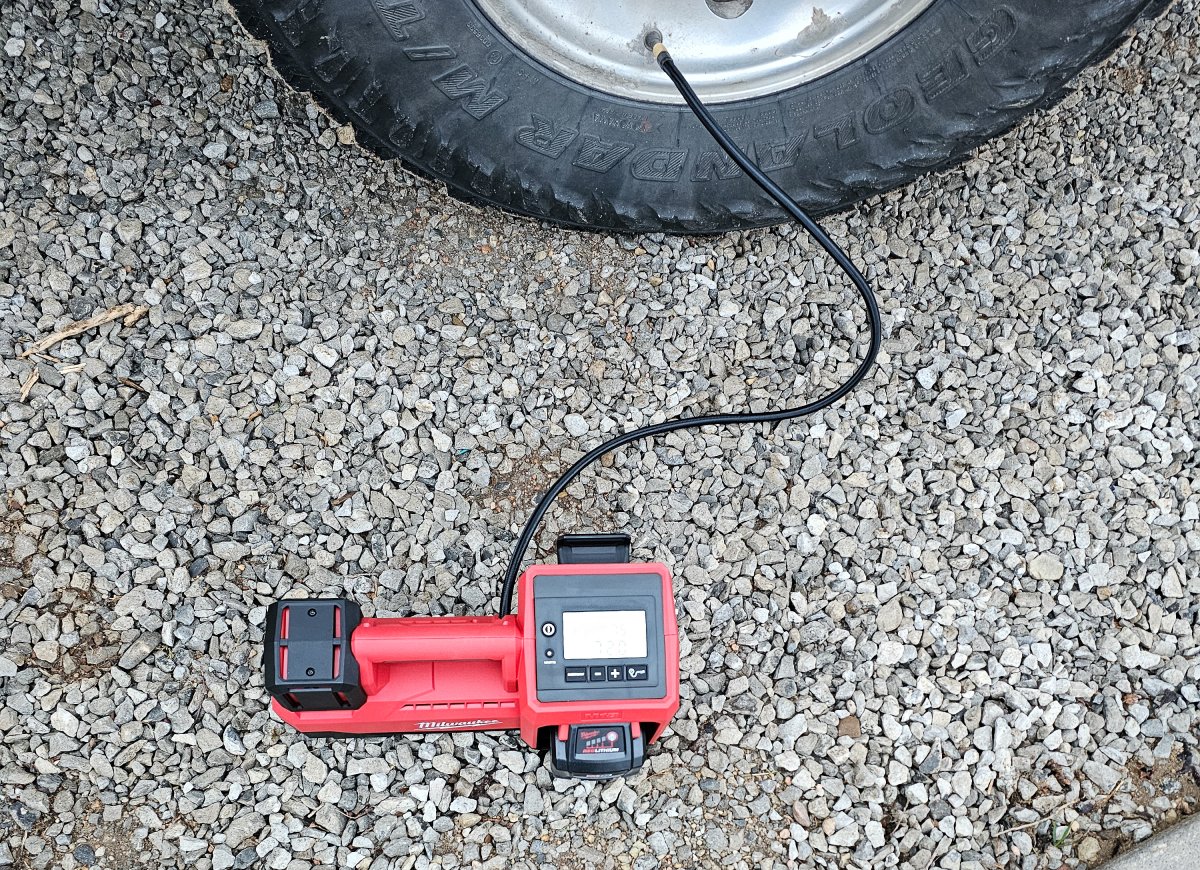
FAQs
If you’re not totally clear on how home air compressors work and which kind might be right for you, take a look at these frequently asked questions and their answers below.
With the help of an electric motor or gas engine, an air compressor converts power into potential energy in the form of compressed air. Air is forced into the tank, where the pressure begins to build. Once the pressure within the tank reaches the tank’s capacity limits, it shuts off until the air is used with a pneumatic tool or manually released.
When used, the air compressor provides a burst or stream of powerful, compressed air to fire nails from a nail gun, spray paint from a sprayer, or loosen automotive fasteners with a ratchet and socket. The tank will then begin repressurizing until it returns to its upper-pressure limits.
The size of the air compressor and tank you’ll need will depend on the type of work you’ll be doing:
– For tasks that require small, intermittent bursts of air, like finish nailing, a small home air compressor (1 to 6 gallons with 1 to 3 CFM at 90 PSI) should be sufficient.
– If the job calls for a more powerful air compressor, we suggest opting for one with a higher PSI and CFM rather than a bigger tank. Smaller tanks are more portable and efficient, and if the PSI and CFM are high enough, the compressor will be able to get the job done without unnecessary bulk or costs.
– Spray-painting calls for a 20- to 80-gallon tank because the output of pressurized air needs to be continuous.
A home air compressor is a versatile tool for many different projects. For example, a small finish nailer can be powered with an air compressor to quickly and easily replace baseboards or door frames. The air compressor could also be paired with a cut-off tool to cut through metal sheets for automotive maintenance or duct repair.
You can also use these tools to power pneumatic drills, frame nailers, and sprayers. They can even be used with an air ratchet to apply additional torque to stuck nuts or bolts. As long as a tool can be powered by compressed air, a home air compressor can be used, though the size and power you’ll need will depend on the tool and the project.

